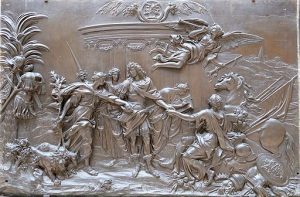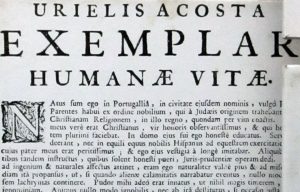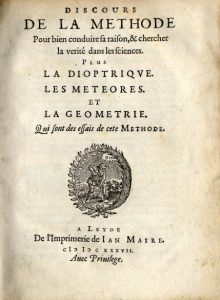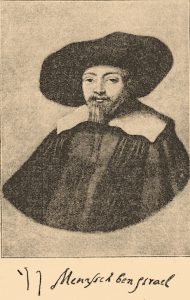
1670 AD to 1690 AD, Psalm 130: Spinoza.
This site was first built in French (see www.147thgeneration.net). The English translation was mainly done using « google translation ». We have tried to correct the result of this translation to avoid interpretation errors. However, it is likely that there are unsatisfactory translations, do not hesitate to communicate them to us for correction.
(for that click on this paragraph)
Summary
This generation of the 1670s and 1680s.
According to our count, this generation is the 130th generation associated with Psalm 130. It is in this Psalm 130 that we therefore find an illustration of the facts of this generation.
The Turkish Empire was at its peak when it decided in 1683 to attack Vienna and fail. It is the end of the European dream for the Ottoman Empire. France appears to be at its peak under the reign of Louis XIV, but the revocation of the Edict of Nantes and the war against Holland in 1672 will be all obstacles to its hegemony in Europe. A new revolution takes place in England.
As the cards are redistributed in Europe, the newly established Jewish community in the United Provinces, Amsterdam in particular, is faced with a new challenge: freedom of worship.
The confrontation between orthodox Judaism resulting from tradition and Portuguese crypto-Jews who returned to Judaism led to the first cracks within the Jewish world in Amsterdam, a territory where the outside world no longer stood in the way of Judaism.
Uriel Da Costa, ex crypto-Jew, who resisted the inquisition in Portugal, not supporting the demands of rabbinical Judaism, ends up committing suicide.
Fifteen years after Uriel’s disappearance, it is not just the Sephardic community that is shaken, but Judaism as a whole. A son of a good family, Baruch Espinosa, will become Spinoza.
Spinoza opposes his religious education with the philosophy of Descartes, the sciences and modernism. He adopts an original philosophical reflection which will pave the way for the main modern philosophical currents.
To this generation, on the conservative side, the attraction to the false Messiah Sabbatai Zevi could have been devastating without an alternative as proposed by Spinoza. Alternative allowing to reconcile religion and science, faith and modernism.
Talk
The new European deal
In this generation [1] of the 1670s and 1680s the sclerosis of the Ottoman Empire seems to stop with the arrival of a new dynasty of great viziers: the Köprülü who succeed one another from 1656 to 1683. They stabilize the government and clean up finances. It is under their domination that the Turkish empire knows its most important territorial expansion. Crete is conquered, Podolia (Piedmont of the Carpathians) and Ukraine pass under Ottoman rule. This supremacy is disputed among others by the Persians and the Habsburgs of Austria and especially by the Russia of Peter the Great who imposes in 1681 the control of the orthodox of the Ottoman Empire.
The fall of the empire took place in 1683. Grand Vizier Kara Mustafa decided to attack Vienna. His defeat is stinging and marks the beginning of the decline of Turkish power in Europe.

While on the eastern side, the Muslim presence in Europe declines, the fate of Europe is played through its Western powers. This generation [2] is thus marked by the reign of Louis XIV, the Sun King, which corresponds to a phase of greatness, at least at the level of the image, of France.

Thanks to the Treaty of the Pyrenees, France made peace with Spain in 1659 and took the opportunity to link Artois, Cerdagne and Roussillon to its territory. While the new powers of northern Europe are moving towards a religious pluralism, France, in the opposite direction, revokes the Edict of Nantes in 1685. This causes the exile of 200 000 Huguenots adding to the economic difficulties of France .
In addition to the Protestants, Jansenism, of which Pascal who marks this time is one of the prestigious representatives, is also fought in a will to suppress the confessional pluralism. Under the influence of Colbert, France discerns the place that the economy now plays in the power of nations, and entered the war against Holland in 1672, thus reversing past alliances.

This war ended in 1678 on the peace of Nijmegen in 1678. This concretizes the failure of a great country like France to kneel the micro-state that represent the 1.5 million inhabitants of the United Provinces , little republic of « cheese merchants ». France limits itself to amputating the United Provinces of Franche Comte and some other territories.
In England [3], after the Cromwell episode, King Charles II embodies the monarchical restoration that also puts an end to puritanism, he will become Catholic only on his deathbed. James II succeeded him in 1685 and asserts himself as a Catholic king, this does not worry the English because James II is old and his daughters are Protestant and married to Protestants. But he gives birth to a son Jacques Edward, baptized Catholic who supplants the Protestant princesses. The reaction causes a new revolution.
Jews faced with freedom of worship
In Amsterdam, the Jewish community is trying to create a unity in a complex context.
Thus, while for many generations, the Jews had only survived within the nations, recently in the new nations, their situation is moving away from the pariah and the practice of religion becomes less complex .
This new freedom is not easy to manage. The first difficulties occur precisely in Amsterdam whereas it is in Amsterdam precisely where the Jews begin to be considered as full citizens, free to practice their Judaism. Many crypto-Jews in the Iberian Peninsula were faithful to the Jewish religion through a direct and personal interpretation of the Bible, the only Jewish book they could possess since embedded in the Christian scriptures. But of course, they could not rely on the Talmud and the other purely Jewish writings that define Jewish practice outside the Iberian Peninsula.

Uriel da Costa, one of the relatives of those who had been arrested by the Inquisition in this generation, and perhaps one of their master-thinkers, had managed to escape in time and had fled to Amsterdam. There he confronts his vision of religion based almost exclusively on the direct interpretation of the Bible to that of rabbinic orthodoxy itself based mainly on the Talmud and all the literature that comes from it.
Crypto-Jews
The confrontation between Orthodox Judaism stemming from tradition and the Judaism of Crypto-Jews returned to Judaism leads to the first fissures in the Jewish world in Amsterdam, territory where the outside world no longer blocks Judaism.
The salvation of the soul of a marranos or its descendants had been the subject of debate in the Jewish community of Amsterdam: for some the return to faith was always possible and saving, for others, the the soul was irretrievably lost.
The confrontation of Judaism from Crypto-Judaism with that of a Jewish orthodoxy, at the same time too distant from the latter and keeping certain distances with those who try to return to the ancestral traditions while ignoring them, favors the appearance of a some form of atheism within the marranos community and their descendants.
The fate of Uriel Da Costa
In Amsterdam, Uriel Da Costa tries to fight the religion imposed by the rabbis.
He suffered a first herem (excommunication) in 1625. He tried to find his salvation in Hamburg without success and returned to Amsterdam and tried to reconcile himself by accepting, in his own words, to make the « monkey among the monkeys », but continued to derogate from many religious practices such as certain dietary practices. He suffered a second herem in 1633.
In unbearable isolation, he once again agrees to return to Orthodoxy by accepting a retraction accompanied by associated sanctions such as the 39 lashes demanded by tradition. Unable to endure this dishonor, he committed suicide in 1640. He survived the confrontation with the Inquisition but not with his coreligionists.
The death of Uriel Da Costa is far from closing the religious problematic of the descendants of marranos, their interrogations with respect to this religion with which they were so far away do not fade:

- Since [4] the tragic end of Uriel Da Costa, the community seemed to be safe from major crises; his apparent orthodoxy could reassure both parnasim and magistrates. We know, however, that she was not safe from a creepy, sneaky crypto-deism against which rabbis and rulers had risen up. Fifteen years after the disappearance of Uriel, it is not only the Sephardic community that will be shaken, but Judaism as a whole. A son of a good family, Baruch Espinosa, will become Spinoza, the philosopher, and this, in spite of the careful Jewish education that had to be given him by the masters chosen by his father, Parnas (administrator of the community) from 1649 to 1650.
For some Spinoza’s break with orthodox Judaism was due to another crypto-Jewish refugee in Amsterdam: Juan de Prado.
Spinoza and the sciences
Juan de Prado began to criticize the definition of God. Called to order by the religious authorities, he pretended at first to make amends but could not avoid the decision of Herem taken against him in 1657. Spinoza himself is struck by Herem in 1656. The large number of Herems pronounced at this time in Amsterdam shows the ideological instability of the members of the Jewish community. But this was more due to the confrontation by the Jewish elites of the time between the Jewish teaching received and the new way of approaching the sciences which were in full expansion at that time.

The teaching of Descartes associated with Greek philosophy and science was thus more likely to sow doubt in Jewish minds:
- Between 1959 and 1660 [5], Spinoza remained in Amsterdam, where he discovered, thanks to Dr. van den Enden, an old Jesuit, the philosophy of Descartes. His spiritual master confirmed him in his break with Judaism, because the pupil did not find in the science and the writings of the rabbis « these obvious truths and built on demonstrations that Descartes recommends to his disciples ».
Spinoza’s primary reaction was a violent reaction to Judaism and to religions in general, all the more so because of the great freedom of expression enjoyed by all the inhabitants of the United Republics. In previous generations, a Jew could survive outside his community only if he abandoned him to join the dominant religion, this is no longer the case in the Netherlands at that time.
Relying on his rational mind, Spinoza’s reaction is a reaction of rejection, rejecting the Jewish religion and its foundations, which earned him the accusation of atheism confirmed by the publication of the theological-political treatise in 1670.
Later, in the nineteenth century, Victor Hugo’s analysis of Spinoza in unsung texts sums up quite well the abyss in which the philosopher finds himself when he tries to redefine a world that no longer relies on religious dogmas:
- The dialogue that Hugo sketches out with Spinoza takes the form of a challenge: shadow-thinker, « solemn voice that seems to clear the night », « sophist, wrestler, embarrassed, hero of the abyss; Horrifying Achilles of Nothingness, « the » fatal reasoner, « who has » demonstrated everything, crushed everything, proved everything, « Spinoza has sent man back to his inanity; out of nothingness, « this terrible nothing », « the gulf of emptiness and eternity (useless, blind, unlimited pitfall) », « this one has only to go back and spoil it: » everything dies « , » all is passable, transformation, flight, avatar, without connection, without relationship, without anything to remember « . Reality has lost its foundation.
Spinoza’s reflection reveals the difficulty of the descendants of Marranos to reconcile with the Judaism of their ancestors. If they do not question the idea of a single God conforming to the biblical image, their questioning places them in a void that could be destructive but which in fact is the basis of philosophy and the modern world.
It is this attitude that evokes the beginning of the psalm of this generation:

- A song of ascents. From the depths I have called You, O Lord.
Indeed, despite the pseudo-atheism displayed by Spinoza in his theological-political treatise in 1670, he reaffirms his belief in a unique and universal God, even if it is outside the dogmas of traditional religions, in his later works; like Ethics in 1677.
Although standing out from traditional Judaism, Spinoza creates his own pantheon without the definition of God (« a God who is confused with the universe ») being incompatible with the Jewish definition.
While adopting an original philosophical reflection that will pave the way for the main modern philosophical currents, Spinoza’s conclusions are not antithetical to those of Jewish orthodoxy:
- Chapter XIV [6] of the « Theological-Political Treatise » defines faith by submission or obedience to God. But what is more interesting in our context is none other than the author’s remark on the dogmas of universal faith: these must not be true, but necessary, because none of these dogmas contains any philosophical truth. perfect on what he states, but must strengthen obedience. Here are the points put forward by Spinoza: God exists, he is unique, he is everywhere, he has supreme power over everything: the worship of God consists in the practice of justice and charity. Only those who obey this rule will be saved. God forgives their sins to the repentant. Finally, Spinoza emphasizes that all these dogmas are necessary, which gives them an essentially political character. In his view, biblical legislation has political and non-religious value.
Spinoza defines a submission to God – even if it is a « redefined » God – a God of justice who encourages sinners to repent of their sins, and a soul to listen to God.
This is what the psalmist expresses in the following of the psalm of this generation:

- O Lord, hearken to my voice; may Your ears be attentive to the voice of my supplications.
- O God, if You keep [a record of] iniquities, O Lord, who will stand?
- For forgiveness is with You, in order that You be feared.
- I hoped, O Lord; yea, my soul hoped, and I wait for His word.
Sabbatai Zevi
If science and modernism undermine the faith of some Jews like Spinoza who wants to stand out from orthodoxy by asking questions about the definition of God and the soul, the soul of those who do not recover question is not quieter.

Indeed, another gulf – much more dangerous – is waiting for the souls of the Jews at this time and this generation, the one that follows the disillusionment of the false messiah Sabbatai Zevi.

Like most other communities in the world at that time, the Jewish community of Amsterdam believed in the messianity of Sabbatai Zevi. Events such as the peace of Münster in 1648 and the decline of Spain, as well as the massacres in Poland, all seemed to confirm the imminence of the Messianic era. Menasseh Ben Israel’s mission to Cromwell was itself imbued with this hope. Those in the Jewish community in Amsterdam who were skeptical about Zevi were putting the community at bay. Community most of whose members in 1666 did not hesitate to display their enthusiasm and were ready to embark for the promised land by abandoning business and commerce.
Spinoza evidently did not allow himself to be carried away by these errors. The sequel to the psalm of this generation thus finds that if the rationalism of Spinoza and the Jews of his generation looking at the world with a critical eye can rightly inspire him with questions, his faith although male expressed is greater than that of those who are ready to give up all rational reason as soon as a messianic hope comes to light.
The latter, rather than seeking their own fulfillment, bring hope only to the imminent redemption of the Jewish people via a providential Messiah. Messianic redemption marking the end of the night, they watch the dawn (Messianic): they are the watchers of the morning.

- My soul is to the Lord among those who await the morning, those who await the morning.



Indeed the Sabbatai Zevi adventure was a dramatic experience for Judaism of that time:
- Shabbetai Zevi [7] died suddenly on September 17, 1676, the day of Atonement. He was fifty years old. A little over three years later, on January 11, 1680, Nathan of Gaza died in his turn. Only their faithful knew of their death.
- Throughout the Mediterranean region and northern Europe, small groups of followers continued to meet; they met to talk about their Messiah and indulged in strange practices, sometimes marked by a sexual nature. They wanted to sanctify evil and hasten the advent of the ultimate redemption: sin itself was sacred in a redeemed world that no longer needed the Law. The movement lasted another hundred years and counted among its members large families of rabbis.
- Few people like to talk about it today. Rabbinical and rationalist scholars seek to denigrate the importance of this movement. However, if Jewish history had known more than one false messiah, no movement had had such an effect on the whole people as that of Shabbetai Zevi and Nathan of Gaza, none had revealed volcanic turbulence and apocalyptic under the rigid surface of rabbinical legalism.
- The people returned to the sinister routine of an endless exile. But the hopes had been too great for us to accept again to passively endure all the sufferings. Historians claim that the number of converted Jews increased during the eighteenth century. The rabbis, who were on their guard against heresies, began to excommunicate those whom they suspected to be followers of Shabbetai Zevi in Germany, Italy, Africa, and Poland.
- According to a remarkable paradox [8], Spinoza promotes two fundamental orientations of modern Judaism: the assimilation first, or even the pure and simple abandonment of Judaism of the tradition, which would be maintained only by « the observation of external rites opposed to those of other nations « and by the » universal hatred « which follows (Theologico-political treatise, III). Assimilation is therefore the ineluctable horizon of the democratic state. Spinoza sees the prospect and the possibility of political Zionism: « I attribute such a value to the sign of circumcision that I alone judge it capable of assuring this Jewish nation an eternal existence; if even the principles of their religion did not soften their hearts, I would believe without reservation, knowing the mutability of human things, that on a given occasion the Jews will re-establish their empire and that God will elect them again (ibid.) « .
As the end of the Psalm indicates, Spinoza’s attitude is superior in terms of fulfillment than those of those who are lost in the false hopes raised by Shabbetai Zevi. Spinoza, outside the refuge in orthodoxy, already sees two paths for the Jewish people, either assimilation or a secular-sounding Zionism.
So unlike Sabbatai Zevi’s followers who want the messianic advent right away, Spinoza rightly thinks that if the coming modernism will lead many Jews astray, another part of those, those who will have kept a few attachments to the fundamental principles of Judaism, will find favor with the Lord and find the way to the promised land.
This is the conclusion of the psalm of this generation:

- Israel, hope to the Lord, for kindness is with the Lord and much redemption is with Him.
- And He will redeem Israel from all their iniquities.

[1] From: (led by) Jean Delumeau: « History of the world from 1492 to 1789 ». « The Decadence of the Ottoman Empire » (French: « Histoire du monde de 1492 à 1789 ». « La décadence de l’empire ottoman» (p. 330 à 333) )
[2] From: (led by) Jean Delumeau: « History of the world from 1492 to 1789 ». « The » Beautiful « reign of Louis XIV », « The end of the reign of Louis XIV » and « The United Provinces » (French: « Histoire du monde de 1492 à 1789 ». « Le « Beau » règne de Louis XIV». (p. 302 à 307), « La fin du règne de Louis XIV » (p. 334 à 336) et « Les Provinces Unies » (p. 314 à 317) )
[3] From: (directed) Jean Delumeau: « History of the world from 1492 to 1789 ». Chapter « The English Restoration ». (French: « Histoire du monde de 1492 à 1789 ». Chapitre « La Restauration anglaise ». (p. 322 à 327) )
[4] Henry Méchoulan: « To be Jewish in Amsterdam at the time of Spinoza ». (French: « Être Juif à Amsterdam au temps de Spinoza ». (p. 137) )
[5] Henry Méchoulan: « To be Jewish in Amsterdam at the time of Spinoza ». (French: « Être Juif à Amsterdam au temps de Spinoza ». (p. 146) )
[6] Maurice Ruben Hayoun: « The Enlightenment of Cordoba in Berlin – An Intellectual History of Judaism (2) ». Preface (« Spinoza, Voltaire and Renan »). (French: « Les Lumières de Cordoue à Berlin – Une histoire intellectuelle du judaïsme (2) ». Préface (« Spinoza, Voltaire et Renan »). (p. XI) ).
[7] Chaim Potok: « A story of the Jewish people ». Chapter: « Secularism: The Messiahs of a Broken World ». (French: « Une histoire du peuple Juif ». Chapitre : « La Laïcité : les Messies d’un monde brisé ». (p. 532,533) ).
[8] Collective directed by Francine Cicurel: « Anthology of Judaism – 3000 years of Jewish culture ». Chapter on Baruch Spinoza. (French: « Anthologie du Judaïsme – 3000 ans de culture juive ». Chapitre sur Baruch Spinoza. (p. 118) ).


